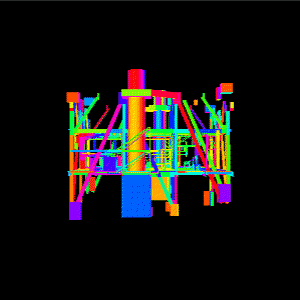SPEC’s ViewPerf - DesignReview Viewset (DRV-06)
A description from SPEC’s site:
“DesignReview is a 3D computer model review package specifically tailored for plant design models consisting of piping, equipment and structural elements such as I-beams, HVAC ducting, and electrical raceways. It allows flexible viewing and manipulation of the model for helping the design team visually track progress, identify interference, locate components, and facilitate project approvals by presenting clear presentations that technical and non-technical audiences can understand.
“The DRV-06 model in this viewset is a subset of the 3D plant model made for the GYDA offshore oil production platform located in the North Sea. DesignReview works from a memory-resident representation of the model that is composed of high-order objects such as pipes, elbows valves, and I-beams. During a plant walkthrough, each view is rendered by transforming these high-order objects to triangle strips or line strips. Tolerancing of each object is done dynamically and only triangles that are front facing are generated. This is apparent in the viewset model as it is rotated. Most DesignReview models are greater than 50 megabytes and are stored as high-order objects. For this reason and for the benefit of dynamic tolerancing and face culling, display lists are not used. “
The test data set is shown below:

There are 6 tests specified by the SPEC DRV-06 viewset that represent the most common operations performed by DesignReview. These tests are as follows:
|
Test |
Weight |
DRV functionality represented |
|
1 |
45% |
Walkthrough rendering of curved surfaces. Each curved object (i.e., pipe, elbow) is rendered as a triangle mesh, depth-buffered, smooth-shaded, with one light and a different color per primitive. |
|
2 |
30% |
Walkthrough rendering of flat surfaces. This is treated as a different test than #1 because normals are sent per facet and a flat shade model is used. |
|
3 |
8% |
For more realism, objects in the model can be textured. This test textures the curved model with linear blending and mipmaps. |
|
4 |
5% |
Texturing applied to the flat model. |
|
5 |
4% |
As an additional way to help visual identification and location of objects, the model may have "screen door" transparency applied. This requires the addition of polygon stippling to test #2 above. |
|
6 |
4% |
To easily spot rendered objects within a complex model, the objects to be identified are rendered as solid and the rest of the view is rendered as a wireframe (line strips). The line strips are depth-buffered, flat-shaded and unlit. Colors are sent per primitive. |
|
7 |
4% |
Two other views are present on the screen to help the user select a model orientation. These views display the position and orientation of the viewer. A wireframe, orthographic projection of the model is used. Depth buffering is not used, so multithreading cannot be used; this preserves draw order. |
The tests were performed at 1280x1024 truecolor Vsync off. The Pro/E profile was selected for the ELSA driver and the 3Dlabs drivers; the NVIDIA 3.65 driver did not have any such tuning options. The scores were:
|
DRV-06 Weight: |
45% |
30% |
8% |
5% |
4% |
4% |
4% |
|
Composite |
|
Test # |
1 |
2 |
3 |
4 |
5 |
6 |
7 |
|
Score |
|
|
fps |
fps |
fps |
fps |
fps |
fps |
fps |
|
|
| Ref. Quadro DDR – NVIDIA 3.65 | 24.5 | 34.4 | 18.4 | 21.3 | 34.3 | 12.8 | 14.1 | 25.43 | |
|
ELSA GLoria II SDR Quadro – ELSA Driver |
23.6 |
33.4 |
17.5 |
20.4 |
33.6 |
13.8 |
13.8 |
|
24.67 |
|
ELSA GLoria II SDR Quadro – NVIDIA 3.65 |
24.7 |
31.6 |
17.9 |
19.9 |
30.8 |
12.7 |
13.9 |
|
24.62 |
|
CL Annihilator 256 SDR - GeForce |
24.4 |
30.9 |
17.9 |
19.7 |
29.8 |
12.7 |
13.9 |
|
24.27 |
|
3Dlabs GVX1 - AGP |
15.4 |
17.9 |
13.2 |
13.4 |
18.4 |
9.35 |
10.5 |
|
15.36 |
|
3Dlabs GVX1 - PCI |
13.2 |
16.0 |
10.1 |
11.7 |
16.7 |
7.87 |
9.20 |
|
13.26 |
|
3Dlabs VX1 |
7.80 |
7.65 |
6.66 |
6.72 |
7.86 |
4.75 |
5.08 |
|
7.327 |
|
Diamond Viper 770 Ultra - TNT2 |
10.1 |
11.8 |
8.42 |
9.13 |
9.36 |
3.38 |
3.41 |
|
9.481 |
The Quadro DDR, GLoria II (Quadro SDR) and GeForce SDR equipped cards scored about the same and were about 60% faster than the next best card, the GVX1-AGP.
Test data posted at the SPEC site shows that only two of the high end workstation systems (that use 700/733 MHz Intel Coppermines with the Intergraph Wildcat 4110 and NEC TE4E graphic systems) score about the same as the Quadro DDR. On this test the GeForce SDR is very close to the Quadro SDR or DDR in performance, this is another example of where the Quadro cards do not offer a large enough performance improvement over the GeForce SDR to justify their added cost.










0 Comments
View All Comments